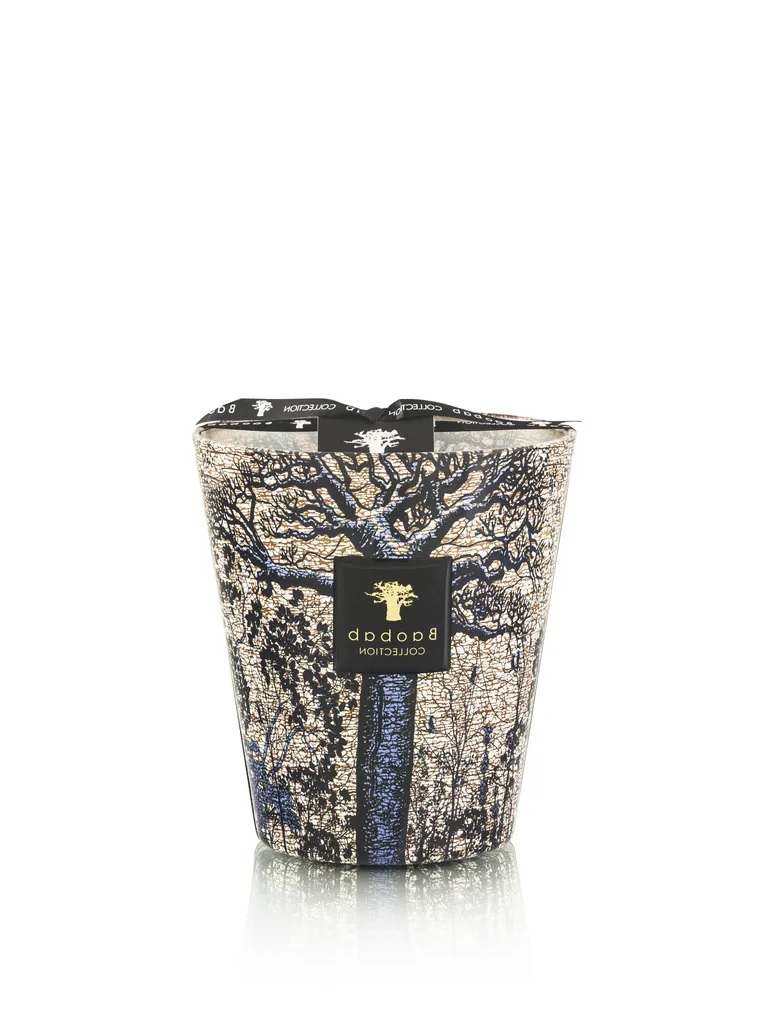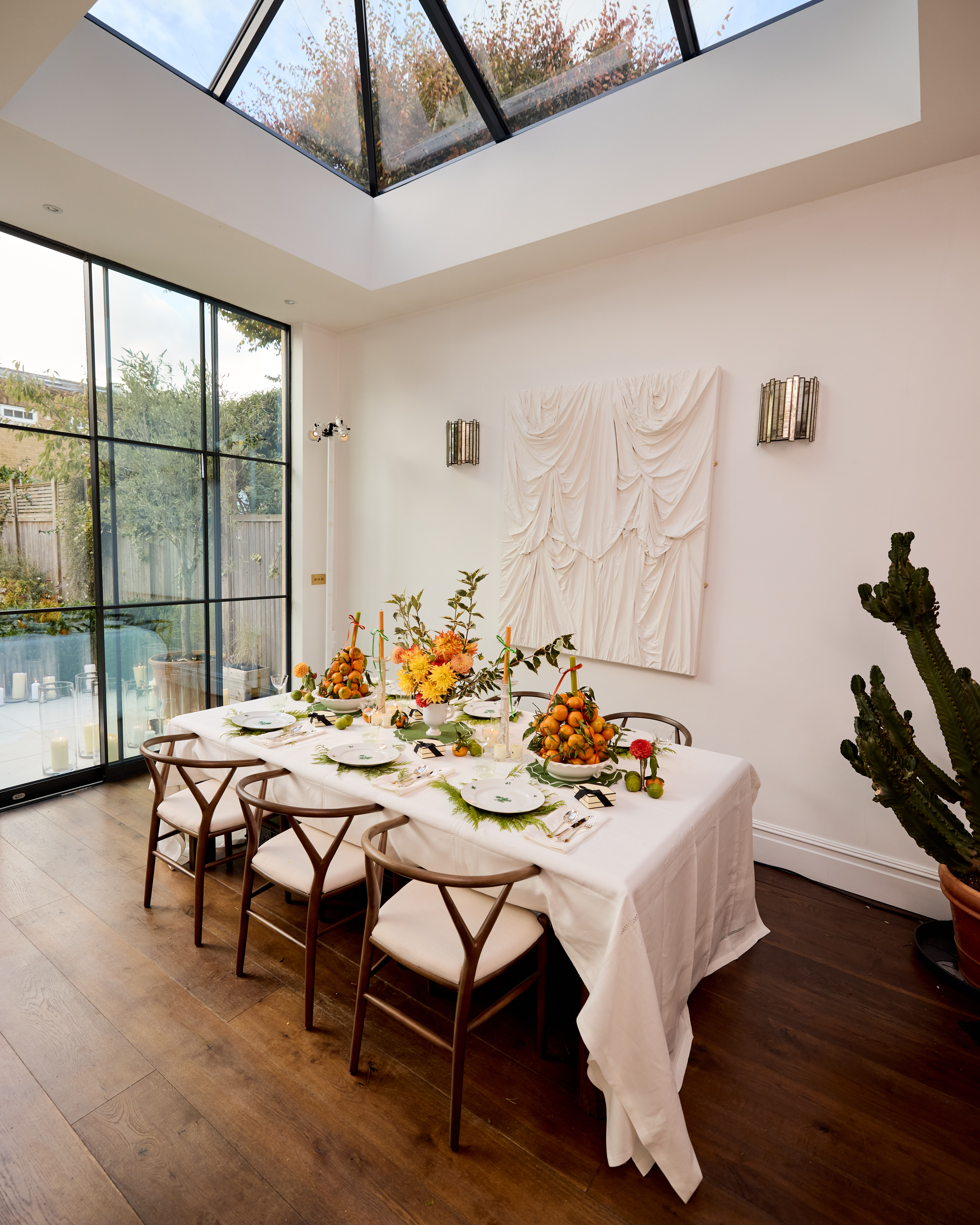
Believe or not, scentscaping, or the practice of scenting the environment around us, has existed for some 7,000 years, with the earliest form of perfume — resin and wood incense — being burned by Mesopotamians during religious ceremonies as far back as 4,000 B.C. Still, "despite having historical roots in ritual and culture, it is something that speaks so profoundly to modern life," Marie du Petit Thouars, founder of fragrance and body care house Maison Louis Marie, tells me.
In the 18th and 19th centuries, "European homes often included 'perfume gardens', while ancient civilizations scented spaces to uplift and transform," she adds. Today, with the increasing pace of our lives, "scentscaping offers a sanctuary — a way to bring intention, calm, or even unexpected joy into our rooms." An act of self-care and creative expression, it isn't just a valuable ally against our stressful routines year-round, but also an unsung hero of our successfully organized dinner parties.
That's right: turning to the mighty, albeit subtle, powers of the best home fragrance solutions might well be the key to stepping up your hosting game this year, whether you're planning on throwing festive gatherings for family and friends, or more intimate dining get-togethers come the New Year. This, of course, isn't anything new. But a renovated interest in the collective experience of food and a craving for offline interactions have made this century-old human tradition more relevant than ever.
Scentscaping: the "Unspoken Element" of Elevated Conviviality

Celine Roux, Head of Fragrance and Lifestyle at Jo Malone London, concurs. During COVID-19, "re-decorating our house and finding new ways of feeling 'at home' became especially prominent," she tells me. Similarly, "when the world opened up again, and we started to feel the need to reconnect with our loved ones, scent too began to play a bigger role in our lives, favoring a new kind of fragrance evolution." So what makes scentscaping particularly pivotal within the context of dinner parties, and what does this "unspoken element" of elevated conviviality — as du Petit Thouars describes it — bring to the table that we shouldn't ignore?
Nowadays, "our homes are a reflection of our style, and scenting your home is an extension of this mechanism," Victoire de Taillac, co-founder of Officine Universelle Buly, tells me. To her, the idea of incorporating fragrance into a social gathering is not just "part of the fun", but also a way "to make your house nicer for your guests and yourself, crafting a better version of everyday life" for everyone to indulge in. Much of its importance lies in the ability to strike great first impressions. "Entering a home that smells good brings instant feelings of warmth and sophistication," says Corinne Bensahel, Creative Director at Baobab Collection. And if this "immaterial hello", as de Taillac calls it, sets the mood for a memorable night, knowing how to pick the best candles, the best essential oil diffusers, and the best incense sticks to evoke your desired ambiance allows you to turn fleeting opinions into long-lasting recollections.
What are the Best Fragrances to Scentscape a Dinner Party?

While, as far as scenting the home for dinner parties, each of the experts stays true to their individual 'nose' and instinct — "follow what you like and you won't go wrong," Roux tells me with a smile — they are united by a preference for understated, non-synthetic fragrances; sensory touches that pleasantly stimulate the senses without overpowering them. "For these kinds of occasions, I always like to think of notes that could be naturally in the room," she tells me. "That's why green tomato vine is a great option for the kitchen: it feels like stepping into a greenhouse in full bloom, and has a very aromatic, herbal essence to it." Pomegranate noir is another one of her favorites, adding a cozier, denser layer to the environment, while simultaneously keeping it fresh and atmospheric.
du Petit Thouars follows a similar approach, blending zingy, botanical, and floral accents for a gentle olfactory experience. At dinner parties, "scent should be a gracious guest and never the main attraction," she explains. Always there to add depth to your home, it should uplift you rather than overwhelming you. "For the kitchen, I like to start with fresh, green, and slightly citrussy notes — think of the gentle crispness of mint or the warmth of basil," du Petit Thouars says, recommending their No. 01 Scalpay or No.09 Vallee de Farney candles. In the living room, soft floral or gentle, smoky undertones like the sandalwood, vetiver, and amber wood ones of the brand's No.04 Bois de Balincourt create a sense of familiarity and invitation, "always allowing the food and the conversation to shine".

Size: 10.58oz

Price: $92.00
What Rooms Should You Scent, and With What Fragrances?

Although most of the action will take place at or around the dinner table, this doesn't mean that the rest of the house should be devoid of fragrance... quite the contrary! According to our home fragrance connoisseurs, the secret to an immersive dinner party-themed, scentscaping experience is playing with multiple scents (or scent-layering) while always bearing in mind the function that each room fulfils.
As de Taillac suggests, your key areas will be the entryway, the living room, and the bathroom or powder room — three rooms that guests will pass through frequently throughout the duration of the event, or spend most of their time in. Of course, there are tricks to maximize the fragrance experience of each of them. In the first two cases, the co-founder enjoys pairing one of Officine Universelle Buly's largest candles, positioned in the 'social' spaces of the house, with a matching, smaller one of the same scent nestled on the doorstep. In the bathroom, she relies on their alabaster home scent diffuser complete with the Alexandrie essential oil, a herbal fusion of lemon, blackcurrant, mint tea, ginger, and vanilla that will maintain its cleansing, refreshing feel till late into the night.

Price: $142.27

Price: $69.99 (was $100.00)
What Moods and Sensations Can Specific Scents Unlock?

The art of home fragrance is primarily known for its ability to imbue our domestic spaces with natural scents reminiscent of countryside, maritime, or alpine getaways, exotic destinations, or the comfort and nostalgia of our childhood days. But making a place smell good isn't the only perk of partaking in this practice. "Room scents have a way of unlocking emotions and memories," du Petit Thouars explains. "Together, they make guests feel welcome, relaxed, and engaged, setting a tone for meaningful conversation and connection."
You could be after a 'girls night out' kind of evening, which Roux recreates with Jo Malone London's lavish, rich Myrrh & Tonka home fragrance line, or planning a romantic, candle-lit dinner, where she'd let serene lavender and moonflower notes constellate the space. Conscious of the comeback of the colder season, Bensahel looks to grapefruit and bergamot as invigorating essential oils that will grant you the spiritedness necessary to make the most of your at-home social life, while pointing to earthy, wood-scented fragrances such as pine, sandalwood, and musk as the ultimate snuggly remedy. To put it in Roux's words, "scentscaping gets much easier when you know what you want": ultimately, it's not about seeking "a spicy or a fresh-smelling candle", but about being aware of the emotions and sensations you and your guests might feel most in need of — be that calm, excitement, escape, or sheer joyfulness.

Price: $319.00

Price: $65.00
How Does Scent Influence Our Experience of Food, and What Fragrances Should We Avoid?

Despite being the perfect testing ground for real scent extravaganza, there are limits that shouldn't be overpassed when it comes to adding fragrance to the dining areas of your parties. As a matter of fact, "scent and taste always work together and influence each other profoundly," du Petit Thouars says. This means that especially strong, permeating fragrances could overshadow, or even take away from, your experience of food, preventing you from "experiencing fully either of them," explains Bensahel.
According to Roux, it is best to stay away from "gourmand" scents — or those perfumes crafted to replicate the smell of edible products and spices like vanilla, cardamom, cinnamon, chai, and chocolate — as these would "confuse" your palate. Valid alternatives for those interested in a pleasantly fragrant tablescape would be "herbaceous scents that can enhance the perception of freshness in food," adds du Petit Thouars, hinting at their No.01 Scalpay, or "warm aromas like our No.10 Aboukir scent, punctuated by eucalyptus, amber, and cedarwood notes that accentuate richness and depth."
Should you prefer to play it safely, placing scented candles on a nearby coffee table, rather than using them as a centerpiece, "adds ambience and instantly warms up the room, creating an inviting and welcoming space for your guests," Bensahel says. She suggests Baobab Collection's White Pearl one, filled with balanced notes of orchid, freesia, and musk, as a good compromise.

Price: $124.44

Price: $96.00 (was $120.00)
Where do I start?

If it all sounds too complicated to recreate by yourself, you'll be pleased to hear that home fragrance expert du Petit Thouars has narrowed her advice on scentscaping at dinner parties down to three essential lessons, listed below.
Choose Complementary Scents: Select fragrances that harmonize with the environment and season. For instance, a light citrus (No.09 Vallee de Farney) in summer or a warm cedar (Le Refuge d’Ernest) in winter.
Mindful Placement: Use scent subtly in areas where guests are most likely to relax or gather, such as the entryway, dining area, or powder room.
Stay Subtle: Less is often more. A gentle hint creates a sophisticated ambiance without overwhelming guests.
What Else is There to Know?

One of the most fascinating aspects of scentscaping is that it allows you to play with different fragrance combinations, not just in terms of notes, but also in regards to format: "diffusers and candles are a great start, and they work especially well in smaller, secluded spaces," Roux says, who also likes to incorporate actual flowers in her scenting journeys, particularly in the entryway for a delicate welcome. Scent-layering, or the practice of mixing multiple fragrance types and items for a more nuanced experience, seems to be the way to go for dinner parties, too, and it is all yours to explore.
Much like with decoration, "you'll have to test and try" a number of solutions to find your favorite ones, says de Taillac. "Burn a candle, close the door, step inside and smell: make some adjustments to the location if necessary, or alter the number of the candles, or see if a diffuser may better suit the situation. The sense of smell is so different amongst people — it should fit your taste."
To conclude with the wise words of du Petit Thouars, "scentscaping at a dinner party is like setting the table; it's an unspoken element that elevates the experience. It tells your guests they're cared for, that there's attention to detail, and that the evening will be unique. It's a sensory offering that, though subtle, leaves a long-term impression."

Price: $56.00 (was $70.00)

Price: $225.00







